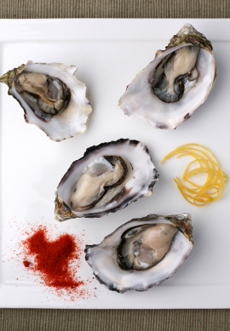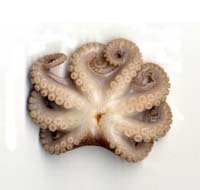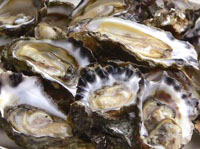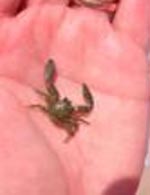

Pacific oysters, generally larger and meatier than Atlantic oysters. Photo by James Antrim | IST.
|
|
| This glossary was compiled by THE NIBBLE EDITORS. It is updated regularly. William Lance Hunt, a freelance writer in New York City, contributed to the first version. |
|
October 2005
Updated October 2009
|
 |
Fish & Seafood Glossary
Page 9: Seafood Types Beginning With O
This is Page 9 of a 13-page glossary featuring different types of fish and seafood. Here, seafood types beginning with O, such as octopus, oyster and oyster crab. Click on the links below to visit other pages. See our 60+ other food glossaries, each featuring a different favorite food.
Click on a letter to get to another section of the glossary.
a b c d e f g h i j k l m n o p q r s t u v w x y z
This glossary is protected by copyright and cannot be reproduced in whole or part.
OCTOPUS
|
Most octopi, regardless of their cinematic and folk reputations, don’t grow beyond two feet including their tentacles, and top out at three pounds. A cephalopod mollusk, the octopus is related to the squid and the cuttlefish. A predator that dines on other mollusks, an octopus has flavorful, though rubbery meat. The body and eight tentacles are edible. The black ink can be used to color and flavor pastas and other dishes. More popular in Japanese and Mediterranean cuisines than in U.S., it can still be found fresh and frozen in supermarkets and specialty markets. Smoked and canned octopus is also available. Octopus can be eaten raw, or prepared in a variety of ways. See also shellfish.
|
|

Photo courtesy of Sxc. |
OYSTER
|
This bivalve mollusk is a culinary favorite found around the world in both natural and cultivated beds. There are three primary species harvested in the United States: the Pacific (or Japanese), Eastern (or Atlantic) and the Olympia. Like wine varietals, an oyster gains its flavor as much from from its terroir (environment) as its species. Thus, they are usually named by where they are harvested.
|
|

Photo courtesy of Sxc. |
Fresh oysters are available year-round, and refrigeration allows them to be eaten during months spelled without an “r”—an old rule of thumb that warned against eating them in the hot summer months when spoilage could cause food poisoning. However, oysters are not at their best in the spring and summer regardless of refrigeration. Oysters spawn then and the meat from spawning oysters is milky and soft.
Enjoyed raw on the half-shell, they can be cooked, shucked into soups, batter-fried, or prepared in special dishes like Oysters Rockefeller (broiled with a topping of herbed and seasoned bread crumbs). Oysters can also be found canned, frozen and smoked. See also shellfish. Because their flavor varies, oysters are usually marketed by where they're grown, so there are scores of market names for the same species. Types of oyster include:
- The kumamoto is a separate species of oyster that has been introduced to the West Coast from Japan. “Kumos,” which are about 2 to 3 inches in shell length, have a very deep cup and a large meat for their size.
- Belon, or European flat oyster (Belon is the name of a region in France where they are grown). Although flats once dominated European oyster production, disease has sharply reduced their harvests. Today, the hardier Pacific accounts for more than 75% of Europe’s oyster production. U.S. oyster growers farm European flat oysters in small quantities on both coasts. Flats, which are prized for their unique salty flavor, sell for a substantial premium.
- Popular eastern oysters include Blue Points (after a town on Long Island, N.Y.), Malpeques (after a bay on Prince Edward Island) and Chincoteagues (an island in Virginia).
- Popular Pacific oysters include Hama Hamas (after a river on Washington's Olympic Peninsula), Shoalwaters (after a bay on the Washington coast), Fanny Bays (on the east coast of Vancouver Island), Yaquina Bays (a bay in Oregon) and so on.
Even oysters of the same species will vary considerably in flavor depending upon where it is grown. Oysters are filter feeders, siphoning up to 25 gallons of water a day through their system. The flavor of their meat is a function of the trace minerals (especially salt) in the water.
Learn more about oysters in our Oyster Glossary.
OYSTER CRAB
|
This tiny soft-shell crab (less than 1 inch wide) is a parasite that lives inside oysters. Usually discarded by oyster farmers, they are also known as “popcorn crabs,” and can be quick fried and added to various dishes, especially soups, for a crunchy texture.
|
|

Photo courtesy of ess.lamar.edu. |
Continue To Page 10: Seafood Terms Beginning With P, Q & R
Go To The Alphabet Index Above
Lifestyle Direct, Inc. All rights reserved. Images are the copyright of their respective owners.

|







